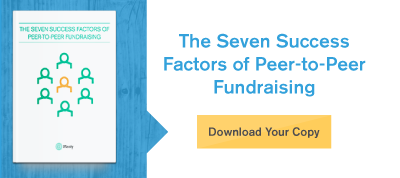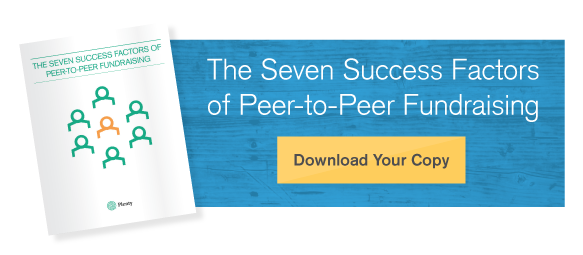Seven Things Keeping You From Peer-to-Peer Fundraising Success
What comes to mind when you think of success? For most of us in the nonprofit space, success equates to fulfilling our organization's mission. Success is knowing that we found a cure, ended poverty, protected the environment, or fully served another worthy cause. But just as these weighty goals are not achieved overnight, neither is your work. Therefore, you often have to focus on the smaller successes that will eventually lead you to achieve your primary goal – creating a better world. The smaller successes typically come in the form of increased advocacy, attracting and activating new fundraisers, and of course, revenue growth.
Revenue growth is the primary driver for most organizations. It is the foundation that allows you to do important work in this world. And while revenue channels vary among organizations, peer-to-peer fundraising programs are typically at the top of a nonprofit’s portfolio. As peer-to-peer experts, Plenty has learned through experience the most important things to consider as you evaluate and improve your program.
Here are the seven things that keep an organization from achieving P2P fundraising success:
1. A Vague Strategy
The first thing to understand when creating a solid strategy is that mission and strategy are not the same thing. While a statement like, “Our mission is to improve the lives of people everywhere by ensuring that everyone has access to clean water,” is a lovely sentiment, it is an ineffective strategy. A clear strategy addresses the primary objective of your program. Your strategy should outline your organization’s position, priorities, and plan for achieving them. It should be clear, concise, and targeted so that you, your team, and leadership are aligned on the top priority of your peer-to-peer program.
2. An Audience That Is Too Broad
A target audience that’s too large can actually hamper your peer-to-peer success instead of generating more revenue. Too often, nonprofits define their audience in the broadest of demographic categories: men over 60, women 25-54, young professionals in their 20s. But similar to having a vague strategy, having a large, nonspecific audience can cause misalignment and impede the growth of your peer-to-peer program. Instead, you need an audience that’s narrowly defined so that you can address them in a specialized manner. In order to create a compelling ask you need to know your audience’s needs, behaviors, motivations and connection to your cause. Once you know this you can communicate with them in a meaningful way.
3. A Half-Hearted Ask
It is easy to assume that as long as you ask for donations you are playing your role in driving revenue. However, this is only the first step. Yes, first and foremost you have to ask for support, but your ask needs to be tailored to your audience, cause, and the channel through which you are communicating. Topics to brainstorm as you craft your ask are:
- “How are our constituents connected to the organization?”
- “How can our constituents help effect the change we’re trying to make?”
- “What support do our constituents need to inspire their network?”
Consider these questions and use the answers to help you construct your asks.
4. A Weak Experience
Your event is one of the biggest touch-points you have with your constituent base. It is personal, interactive, and crucial to deepening their relationship with your organization – but it isn’t everything. In fact, your event is just one of many touch-points you have with your constituents, each of which is important to building and sustaining their loyalty to your cause. While a goal of your program should be to plan and execute a flawless event that leaves participants feeling connected to your mission, you also need to consider the interactions they have with your organization before, during, and after your event in order to create a truly effective experience for your constituents. Make sure you have the following basics in place:
- A user-friendly website that functions intuitively on any device
- Online and e-mail communications that are clear, well-written, engaging, encouraging, and useful
- Recognition and stewardship programs that recognize people based on their connection to your cause
- An event that communicates your mission and also provides the basics: water stations, restrooms, a clear site layout, and helpful and timely announcements before and during the event
5. A Low Level Of Constituent Support
If you’re leading a peer-to-peer team, it’s safe to say you’re juggling a million different tasks and priorities. This is the reality for many nonprofit staff members, but it is also the primary reason why priorities, such as constituent support, are placed on the back burner. It is easy to get caught up in planning year-round campaigns that ask for your constituents’ help without pausing to think about what support they may need.
A key component of successful peer-to-peer fundraising programs is providing great service to your constituents. This means giving them the encouragement, instruction, and information they need to be successful fundraisers. Their success after all is shared with your organization. So it is critical to think about how you and your team can improve the processes and services that directly support your constituent base.
6. Underdeveloped Analytics
Nonprofits are founded on empathy and the unifying vision of creating a better world. However, it is no longer enough for nonprofits to just have a vision. Instead, they must also have a strategic plan for achieving it and the metrics to prove they are doing so.
As constituents increasingly require numerical proof of impact, organizations of all sizes will need to lean more heavily on data and analytics to maintain and grow their fundraising base. Your data is the tool through which you can communicate your impact and get an in-depth look at your program’s strengths and weaknesses. And remember, you don’t need to track every possible number to be successful – just the metrics that drive revenue.
7. Lack of Alignment
If everyone on your team is on a different page regarding your program’s mission, strategy, and goals, it becomes nearly impossible to be effective in your actions. Instead, your team is scattered in different directions costing you time, money, and resources. To avoid this make sure you and your team are aligned around the goals of your program and that everyone’s role in achieving those goals is clearly defined. Alignment and accountability are key to increasing the effectiveness and efficiency of your team and ultimately growing your program.
For a deeper look at the seven issues that hinder peer-to-peer program growth download our Seven Success Factors E-Book!
Share this
You May Also Like
These Related Stories

Seven Things All Peer-to-Peer Fundraising Leaders Should Do

Harnessing Data In Peer-to-Peer: Success Factor #6




Comments (2)